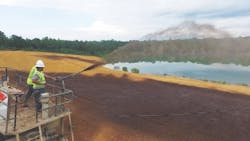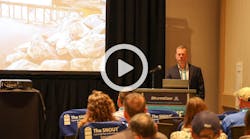Following Fundamentals
About the author: Michael Robeson, P.E., CPESC, CPSWQ, CESSWI, is research & development manager for Profile Products. Robeson can be reached at [email protected] or 970.481.6932.
For 13 years, an abandoned mine in the Southeast U.S. sat partially barren. A large mining company had worked to revegetate and obtain reclamation release of a 5-acre portion of the site near a water body several times over the years with traditional seeding operations. Every time the site experienced a typical rain event for the region, significant erosion took place and seeds were washed away, preventing the mine from obtaining the project reclamation release. Further, the small amount of vegetation that was able to establish struggled to succeed. In November 2015, the mining company had reached the point where they had to close out the project site and obtain the reclamation release from the regional authority, and a fourth failed attempt at revegetation was not an option.
Photos of the site and various test values were monitored throughout the project.
Back to Basics
Knowing that the ultimate goal for this site was reclamation and seamless integration into the surrounding landscape, Profile Products was brought in to assess the project site and used the five fundamentals for reclamation to improve soil health, and steer the project toward sustainable vegetation and ultimate reclamation.
The five fundamentals include:
- Soil Testing: The soils had low pH, very limited organic matter and biological activity. This led to the recommendation of a custom blend of micronized lime for pH, and biotic soil technology to manage low organics and limited biological activity.
- Seed Selection: Analysis of the surrounding area and regional conditions determined that a blend of brown top millet, bahia and bermuda grass was the most appropriate seed mix to advance reclamation.
- Erosion Selection: Highly erodible soils in a region with significant rain events led to the selection of a hydraulically applied, high-performance, flexible growth medium for erosion protection.
- Proper Installation: A contractor experienced with all of the selected products and materials was chosen to ensure installation was smooth and efficient.
- Inspection & Maintenance: The site was monitored by the manufacturer and the engineering firm, as well as inspected by the regional reclamation authority to determine potential project release.
With these fundamentals in mind, the selected materials and products determined from the process led to improved soil health and sustainable vegetation, which will lead to full reclamation for the mine site. Healthy soils provide the capacity for a living ecosystem that sustains plants, animals and humans through nutrient cycling, filtering and buffering, as well as biodiversity. Once the soils are on the path to becoming healthy, sustainable vegetation can occur, leading to reclamation. Key elements of healthy soils include minerals, organic matter, biological activity, water and air. Minerals, water and air typically are unable to be managed due to the fact that site designers prefer to rely on existing soils and natural rainfall conditions. As such, from a design standpoint, the two key parameters that can be managed for improved soil health are organic matter and biological activity.
Given that organic matter and biological activity are the two key items to manage for soil health, the manufacturer decided to monitor these values over time on this site to determine if soil health was improving, if this project had sustainable vegetation and if it was on the path to reclamation. Site photos and test values of soil organic matter, soil respiration (an indicator of biological activity), as well as total biological counts were monitored from project initiation in March 2016 to September 2017 to provide validation and reclamation release.
The sustainable vegetation quickly approached full reclamation.
Just in Time
The site was regraded, and the selected materials and products were installed in April 2016. In early June 2016, Tropical Storm Colin hit the project site and dumped 5 in. of rain in a 36-hour period. The site was inspected by the design engineer.
“The site did remarkably well with no erosion, rills, gullies or ditches forming, not even small rills. The ProGanics, Flexterra and soil amendments stayed in place after the event, and the project area benefited from the overall design. The water clarity in the lake was clear and the site withstood a significant storm event,” said the design engineer.
By Sept. 1, 2016, the project was approved for reclamation release by the regional authority. An interesting note about this project and timing was that one day after the project was released by the regional authority, Hurricane Hermine hit the area and dropped 6 to 10 in. of rain in a 24-hour period. The site held up well and there were no issues to report.
In regards to soil health, the key parameters of organic matter and biological activity increased significantly over the 18-month testing period, a clear indicator that sustainable vegetation has been achieved and reclamation is underway. The ultimate goal for this site of reclamation and seamless integration into the surrounding landscape is well on its way, proven by reclamation release and tracked soil health data parameters, which demonstrates that a project following the five fundamentals of reclamation, in conjunction with biotic soil technology and flexible growth media, can lead to sustainable vegetation and eventually full reclamation.


